How do the first stages of launch vehicles land?
Preface:
We all have the images in our minds of some famous extraterrestrial landings: Apollo (Moon), InSight (Mars), Huygens (Titan), Philae (Rosetta), MASCOT (Ryugu) and many others. Recently, we notice more and more superb videos and photographs of spacecraft landing on Earth, and not those of the Soyuz returning from the ISS but those of the first stages of launch vehicles. Why? How? I will explain all of this in this article which will cover the topics of Falcon Heavy, rocket guidance and launch vehicle engines !
Introduction :
The Launch Trajectory:
A launch vehicle lifting off from its launch pad takes, of course, a vertical trajectory, but it also has a horizontal velocity! This article on orbits explains how an orbit is achieved using horizontal velocity. Going higher up into space will only make it fall faster!
This is why nearly all launches leave traces of an arc and have a tilted trajectory during the flight, as seen here from the launch of the shuttle Atlantis.
 (C) NASA
(C) NASA
So, if we want to bring back a launch vehicle near (or even on, we will discuss this later) its launch pad site, it must fall back down (easy, the gravity will help), turn around, and reignite the engines to counter the horizontal inertia”.
The footprint is the name for the launch trajectory projected on the ground. In other words, for a satellite, it's the imaginary line drawn on the ground that represents its orbit. But for a launch vehicle stage coming back down, we would see its line going away from its launch site as it goes up, then make a sort of U-turn before coming back down to the nearby landing zones, such as, for example, the launch pads in Florida for SpaceX.
The launch vehicle must reduce its mechanical energy (kinetic and gravitational potential) that it has itself accumulated! It must use simultaneously its engines and adapted braking methods, such as grid fins, for example.
 (C) SpaceX
(C) SpaceX
Plan:
We will start by discussing the landing theory, then how SpaceX was able to have successful landings one after the other, some future projects (including those outside of SpaceX) and finally, landing zones and drone ships.
The Landing:
Let’s take SpaceX as an example (even if we will discuss other companies and projects further on in this article). Before pulling off their spectacular feat of engineering that was the double booster landing following the launch of the Falcon Heavy, the SpaceX teams had to overcome the difficulties that any project of reusable launch systems must face.
 (C) Royalty-free
(C) Royalty-free
There it is, the theoretical trajectory of a launch with a return on a drone ship at sea (which we will discuss later as well). A few precisions: Here, the boostback is not absolutely necessary: not having to return to a landing zone close to the launch site, the SpaceX teams have two choices. Either they send the drone ship to the place where the first stage will come down under its own inertia, which entails a long return trip, or they send it to a location close to the launch site which implies a boostback burn. Second precision, the grid fins are now deployed BEFORE the re-entry burn. Finally, the landing burn is first made with three, the one single Merlin D+ engine.
Trajectory example:
 (C) SpaceX
(C) SpaceX
After having launched the second stage towards a suborbital trajectory , the first stage separates from the remaining portion of the launch vehicle at an altitude of about 110km.
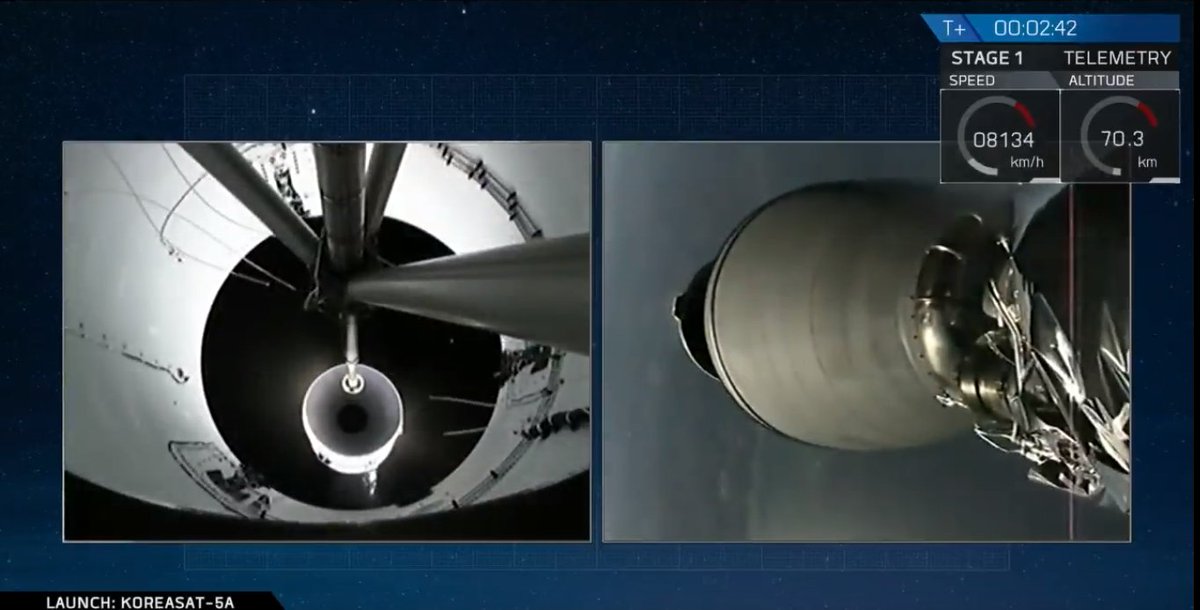 (C) SpaceX
(C) SpaceX
The first stage turns around using its nitrogen RCS (Reaction Control System) and deploys its grid fins before igniting any one of its three motors at varying burn rates: this is the famous “Boostback Burn” that serves to bring the stage into a trajectory of atmospheric re-entry and towards its landing site. Some boostback maneuvers allow for a return nearly spot-on to the original launch site (such as the boosters for Falcon Heavy), which requires turning around while the launch vehicle is traveling at speeds of several thousand kilometers per hour!
 (C) Mike Kitaif
(C) Mike Kitaif
In this photo taken by Mike Kitaif during the launch of Falcon 9, we can distinguish on the left side the second stage that has ignited its Merlin Vacuum engine for orbit insertion (its flame spreads out daily due to the lack of ambiant pressure), while on the right side we see the first stage performing its boostback burn. The flames meet in the center of the image, creating an aspect of a supernova or nebula.
Once the first stage is on a re-entry trajectory and after a slight period of calm, it will be subjected to the heating and aerodynamic forces of atmospheric re-entry.

(C) SpaceX
During the atmospheric reentry, the stage reignites its engines for light braking, passing from a hypersonic flight to “only” a supersonic one. This prevents not only excessive heating or dislocating the stage, but also allows to refine the trajectory.
Once inside the layers of dense air, the first stage will combine its grid fins and its general aerodynamic form to guide itself. Indeed, these grids that are about 2 meters from the sides allow the 50-meter stage to orient itself approximately 20 degrees on 3 axes! The tubular form gives a slight lift effect, bending the trajectory towards the landing site.
Elsewhere, this lift effect helps ensure the safety of those living near the launch site! During the launch of the Cargo Dragon to the ISS for mission CRS-16, the hydraulic pump of the booster dislodged, blocking the grid fins from aligning properly and created a continuous rotating force.
 (C) SpaceX
(C) SpaceX
If the stage was unable to generate any lift, the SpaceX teams would have to launch it straight towards the landing zone which would, in the event of a failure, risk a crash either in the surrounding residencies or on the drone ship. However, by using this lift, they direct it first towards the ocean before having it “float” towards the landing zone using the grid fins. The stage from flight CRS-16 managed to land in the ocean anyway with two of its three engines pivoting on the final burn to counteract the rotation.
Getting back to our trajectory, once on the final approach to the landing site, the stage sets itself upright, ignites its central engine (lower and more agile than the others) and two auxiliary engines, braking hard before cutting the auxiliary engines and allowing the central engine to pivot and slow down the stage. During the space braking, the landing gears deploy simultaneously to reduce even more the rotation potential by kinetic moment effect (more explications).
The touchdown is made at a maximum speed of 6 meters per second. The landing zones or drone ships are wide enough (86m diameter for landing zones and 90m x 52m for drone ships) that the stage can touchdown outside of the perfect center. Remember that both landing zones LZ-1 & LZ-2 are not GPS guided, only drone ships are guided by GPS and come together by information coming from space! Millimetric precision is, of course, not possible.

To conclude with the trajectory, here is an image created by John Kraus, showing a Falcon 9 lifting off (on the left) and its stage coming back down (on the right with the entry burn on top, landing burn at the bottom).
 (C) John Kraus
(C) John Kraus
History of the SpaceX Fleet and Development:
Before creating world famous landings with the two boosters of Falcon Heavy, the SpaceX teams had to overcome numerous challenges. In the span of six years, SpaceX had announced and launched numerous types of rockets. For starters, let's talk about the Grasshopper. Announced in 2011, two years after the last flight of Falcon 1, it is the suborbital rocket dedicated to studying vertical landings (and what luck, that is the subject of this article!).
Grasshopper:
The Grasshopper was simply a fuel tank from the first stage of Falcon 1 with a single Marlin 1D engine and measuring 32 meters high. Its landing gear was, for the moment, fixed.
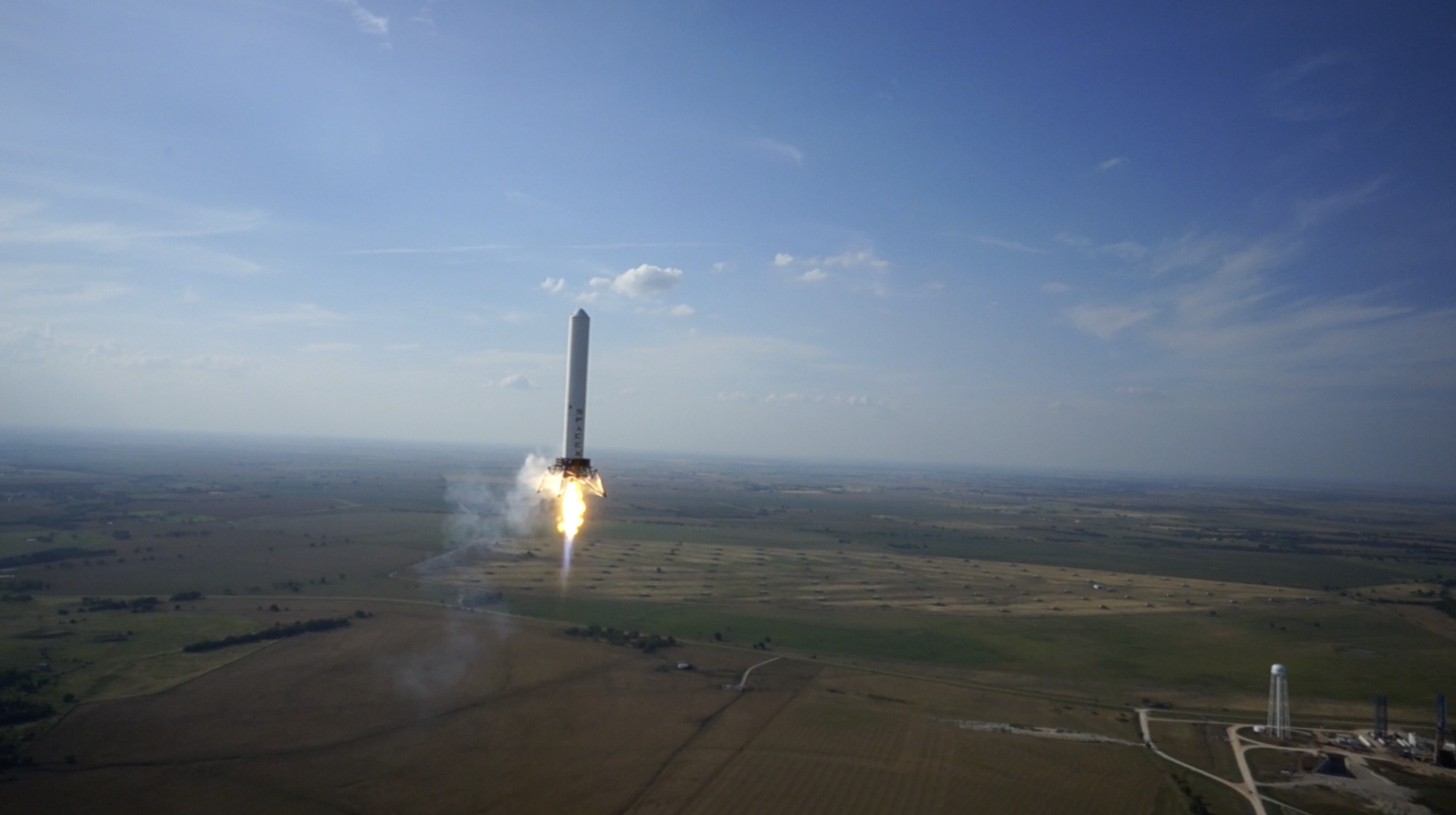 (C) SpaceX
(C) SpaceX
Test flights were carried out in 3 phases: vertical takeoff, climbing to the target altitude, then a low speed descent and vertical landing. These flights lasted between 3 and 79 seconds. Their apogee varied between 2 and 745 meters of altitude over Texas. The Grasshopper was launched 8 times. The first flight in September 2012 was a simple hop 2 meters high and lasted 3 seconds with a near empty tank. During its third flight, it performed its first “hover” (nearly stationary flight) at an altitude of 40 meters before slowly coming down for a landing. Another remarkable flight was its second to last launch, during which the Grasshopper performed a lateral shift for a distance of about a hundred meters before coming down on its launch zone.
Elon Musk described the Grasshopper as being able to “land on Earth with the accuracy of a helicopter.”
The SpaceX teams, satisfied by these flights, then decided to launch the development of a test model for the Falcon 9, larger and more massive than the Falcon 1.
F9R Dev1/2 :
The F9R Dev1 was the “robust” version of the F9R: a full size Falcon 9 tank, retractable legs, and later on, grid fins! This model allowed to validate the return flight models of the Falcon 9 and numerous techniques such as deploying the legs, steering by grid fins, and flight trajectories.
 (C)SpaceX
(C)SpaceX
The F9R is nearly twice as big as the Grasshopper at a height of 49 meters! Its retractable landing gear via a telescopic piston was much less heavier than the large, fixed metal structure attached to the Grasshopper, plus it improved the aerodynamics. Deployed using pressurized helium, the legs span 18 meters and weigh 2100kg. Additionally, the engine bay also varies from that of the Grasshopper: the F9R had 3 Merlin 1D engines allowing it to vary ignitions and trajectories during the tests.
Its first flight took place in April 2014, climbing to an altitude of 250m before performing a hovering maneuver, shifting horizontally and then coming back down on the launch pad. It was equipped with its first Grid Fins for its third flight.
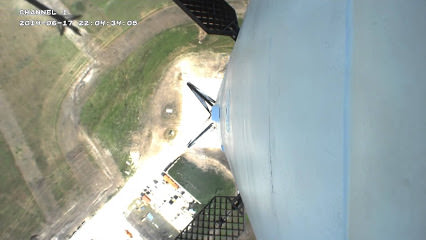 (C)SpaceX
(C)SpaceX
However, during its 5th flight, a sensor gave an erroneous signal that caused the F9R to deviate from its path and activate the flight termination system.
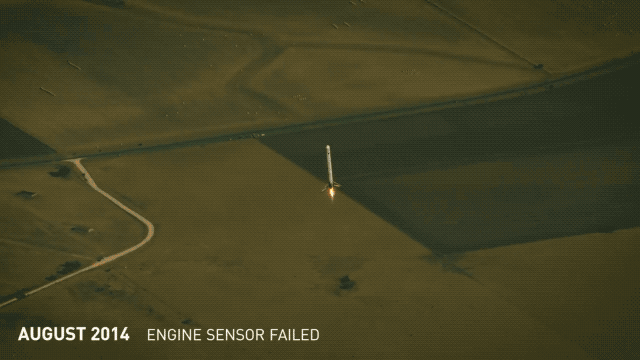 (C)SpaceX
(C)SpaceX
 (C)SpaceX
(C)SpaceX
SpaceX had announced the F9R Dev2, an improved version of the F9R Dev1, that was supposed to be launched from the very high altitude of SpacePort America, but it was eventually decided to use their commercial Falcon 9 for the rest of the development.
Falcon 9:
The SpaceX teams quickly equipped the Falcon 9 with grid fins and landing legs, all while making improvements to these attachments along the way: titanium grid fins, retractable landing legs instead of removable ones, etc.
The most important was, of course, to make the launch vehicle stage come back…which turned out to be much more complex that it seemed! Indeed, if the Grasshopper and F9R flights had been huge successes, bringing back a booster from a height of 110km moving at several thousands of kilometers per hour relative to the launch site is not the same thing.
.jpg) (C)SpaceX
(C)SpaceX
Between 2013 and 2016, the Falcon 9 started its testing. By 2017 the landings had nearly become routine!
The EDL (Entry Decent & Landing) phases gradually improved after (numerous) failures.
The first test of this system happened during during the sixth Falcon 9 flight (it just goes to show that this launch vehicle was really destined for reutilization) in September 2013 and marked the first flight of the F9 v1.1.
For the flight of the CRS-3, the stage followed the plotted trajectory needed to land on the drone ship, except that SpaceX would not risk its barge and let the stage come down in the water.
Even if the stages were near to performing perfect landings…failures were still common! Oops, just a reminder: the stage measured a height of 50 meters and weight about 300 tons!
 (C)SpaceX
(C)SpaceX
All the flights since that one ended their launch with a landing test, more or less gentle, more or less precise, and sometimes with a soft landing…just before collapsing on itself!
The first landing of a Falcon 9 stage happened in December 2015 on the LZ-1 (which we will talk about later). The first drone ship landing happened in April 2016, and its booster was the first to be reused, and to be recovered a second time!
FINALLY!
 (C)SpaceX
(C)SpaceX
Between 2013 and 2016, SpaceX launched 16 (commercial) test flights, of which 6 succeeded the feat of landing softly (and staying in one piece AFTER the landing):
- Flight 20 (OrbComm OG2 M2) = Landed on LZ-1 in December 2015.
- Flight 23 (CRS 8) = First STABLE landing on the drone ship "Of Course I Still Love You" (OCISLY) in Avril 2016 in the Atlantic. The 4 previous tests had brought the booster to the drone ship, but they were destroyed upon landing (jammed grid fin, fall angle too high, engine cut-out too soon…)
- Flight 24 (JCSAT-14) & Flight 25 (Thicom 8) = First to return from high speed velocities of GTO launches, on the drone ships. To land at such speeds, the booster ignites its 3 outer engines during a short period then lands with only its central engine.
- Flight 27 (CRS 9) = Landed on LZ-1 in July 2016.
- Flight 28 (JCSAT-16) = Landed on OCISLY in August 2016.
After these flights, landings went from being experimental to routine.
Nevertheless, the SpaceX teams put up a video dedicated to the failures that happened during the landing tests, a hilarious communication and representative of the improvements!
Progressively improving its trajectories (optimization of fuel consumption and structure wear), its materials (grid fin resistance, maintenance of landing legs), the Falcon 9 evolved into the Block 5, its current version with matte black landing legs.

/cdn.vox-cdn.com/uploads/chorus_image/image/59709159/Screen_Shot_2018_05_11_at_4.22.56_PM.0.png) (C)SpaceX
(C)SpaceX
This version, lighter but more powerful, is capable of heavy loads and a theoretical easier reutilization.
Now that the landing of ONE stage has been mastered… why not land them in a group?
Falcon Heavy :
The Falcon Heavy, which we previously discussed here is, for the moment, the heaviest of SpaceX’s launch vehicles. Combining a “standard” Falcon 9 and two first stages of an F9 on the sides, the launch vehicle goes up as a single unit, then separates into FOUR rockets during the flight: the 2 side boosters who will return and land on LZ-1 and LZ-2, the main stage that will land on a drone ship, and the upper stage that takes off to insert the payload into the desired orbit.
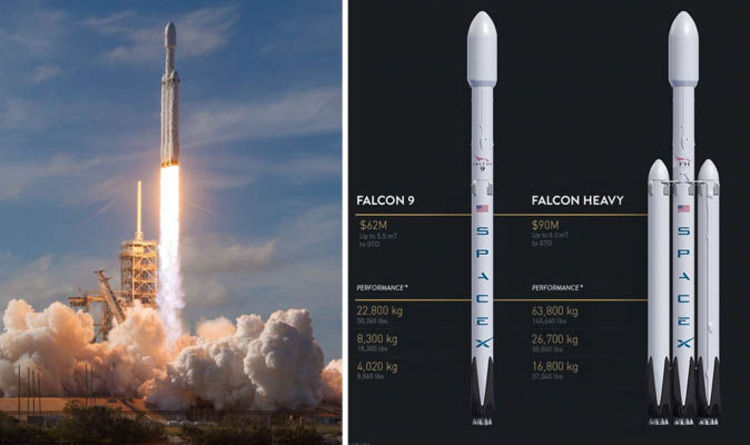
The big challenge of these launches is then to manage 4 stages simultaneously, especially during the return of the boosters who land within a few hundred meters of each other!
 (C) SpaceX
(C) SpaceX
Quick summary of the first launch (I suggest reading the article on this site about the Falcon Heavy for more details!): the two boosters land at the same time on the SpaceX landing zones, the central stage was missing a TEA - TEB (a mixture that serves to ignite the engines) and so only had braking with a single Merlin engine instead of 3…which resulted in a crash next to the drone ship!
 (C) SpaceX
(C) SpaceX
The next launch should happen soon, maybe a chance to finally have all 3 stages return at the same time?
Starhopper:
Also called Starship Hopper, the suborbital launch vehicle is a kind of Grasshopper or F9R dedicated to validating the Raptor engines and provide a model for the next interplanetary vessel: the Starship (a.k.a. BFR, then ITS).
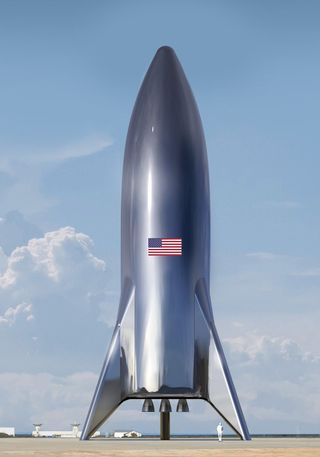 (C) SpaceX
(C) SpaceX
This test rocket is therefore destined to analyze how the Starship will handle in flight, and the performance of the new SpaceX engines, the Raptors. Here is a link dedicated to rocket engines if you would like to understand how these closed cycle engines using liquid methane function.
 (C) SpaceX
(C) SpaceX
It was supposed to have a classic rocket form but after some very strong winds, the upper portion of the Hopper collapsed, leaving the Hopper with this form very unusual for a rocket!
 (C) SpaceX
(C) SpaceX
Future Projects and Engineering Challenges:
We have summed up the past and present fleet of SpaceX, let’s move on to recovery projects:
Payload Fairings:
It has been detailed in this article here, but the fairing recovery is an important subject in space news. A fairing can cost up to 5 million dollars and usually ends up in the ocean! Recovering part of it allows to reduce launch costs and facilitate access to space.
(C) SpaceX
Second Stages:
Once again, SpaceX has some original ideas!
Bringing back a second stage allows for relaunching a rocket by simply refilling its tanks.
 (C) OliGoMeta/Reddit
(C) OliGoMeta/Reddit
However, the second stages often go out into orbits with a strong apoapsis, like those of the GTO, and fall from an altitude of 35786 km, creating an energy so strong that the rocket loses an enormous payload capacity due to the weight of its thermal shield.
Other problem: igniting an engine in atmosphere when it was designed for operation in the vacuum of space creates strong turbulence inside the engine, leading to its destruction. It must use either a parachute (for the heavy stage, its nearly impossible), or an engine equipped for atmosphere (which the rocket would lose performance in vacuum).
Recovering this kind of stage is then, for the moment, impossible.
Starship & Mars:
The Starship is the upper stage connected to a Super Heavy booster. If you have a hard time recognizing these words, it’s because this rocket has often changed names!
 (C) SpaceX
(C) SpaceX
Equipped with over thirty Raptor engines on the first stage (!) and 7 Raptor engines on the vessel itself, it is a monstrous launch vehicle. The first estimates give it a height of about 100 meters and more than 4500 tons at liftoff!
Three different versions of this launch vehicle exist: one dedicated to astronaut transport, one for launching large satellites, and one destined for refueling the other versions.

The Starship will have to place itself in orbit with its crew while the Super Heavy booster comes back to land on the launchpad (the precision required is incredible!), the a tanker Starship will refill the tanks of the crewed vessel so that it can take the trip to Mars!
It will land on Mars, take off later and come back to Earth.
The first mission for Starship will be the #dearMoon project that will send the Japanese millionaire Yusaku Maezawa as well as other artists around the moon.

Its technical demonstration model, the Hopper that we discussed earlier, had only taken off a few centimeters at the time of writing these lines. Will we one day see the Starship fly?
 (C) SpaceX
(C) SpaceX
Callisto, Blue Origin, etc:
SpaceX isn’t the only company looking towards reuseable stages (and well, people can criticize the attachment to SpaceX during this article!). CNES has the Callisto project and Blue Origin is working relentlessly to develop the launch vehicles of the future.
Callisto and CNES:
Le Centre National d’Etudes Spatiales (the national center for space studies) has recently unveiled Callisto: a 15-meter high space vehicle that is entirely reuseable. Its first flight is scheduled at the space center in French Guiana at the end of 2020, performing a round trip flight up to an altitude of about 50 km.
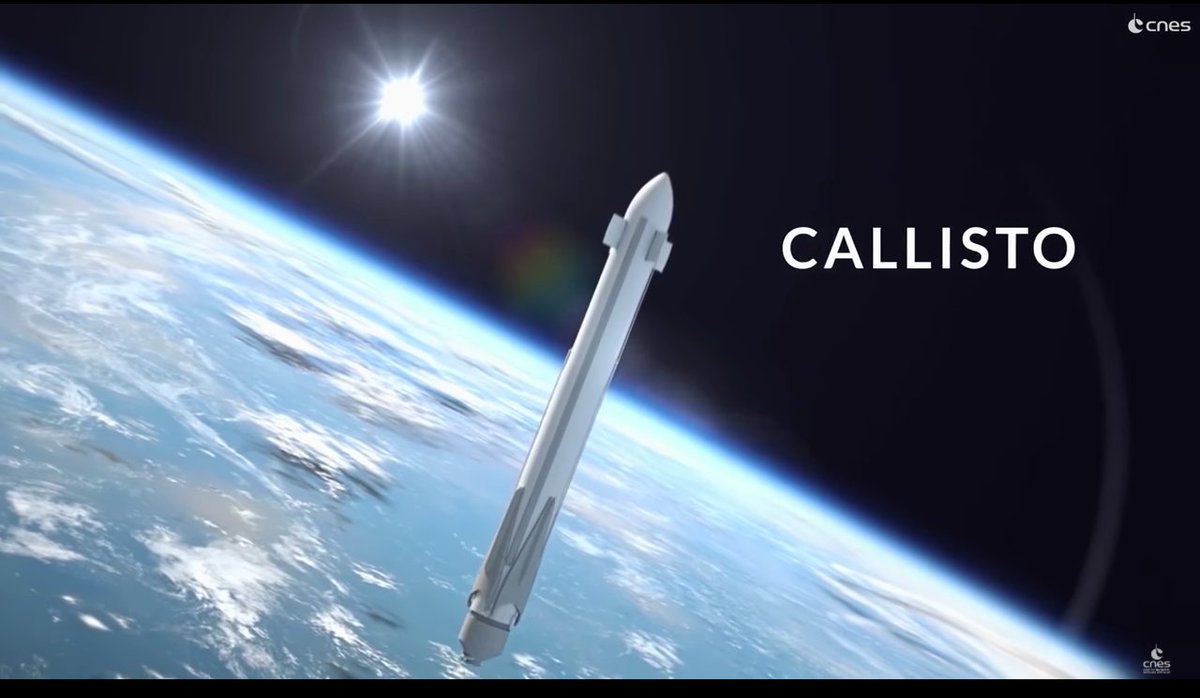 (C) CNES
(C) CNES
Here is what they have to say: “The reutilization is a path explored by the American companies SpaceX and Blue Origin. Since the early 80’s, CNES has been working on this concept but the studies have never resulted in a successful, concrete demonstration. To mitigate this lacking, CNES has decided to launch, in conjonction with international partners, several test flights of a small, entirely reuseable space vehicle baptized Callisto.
15 meters tall and 1 meter wide, Callisto will be equipped with a reusable cryogenic engine that functions on hydrogen and oxygen. Callisto is not intended to become an operational vehicle. It is a demonstration intended to perform tests in flight to master the complex return of a launch vehicle, to revalidate operations between 2 flights, and to calculate precisely the cost of a European launch vehicle for which the first stage is reuseable.
An acronym for ‘Cooperative Action Leading to Launcher Innovation in Stage Toss-back Operations,’ Callisto is a project led since November 2015 mostly by CNES and the German space agency (DLR). CNES is responsible for the architectural studies of the vehicle and the ground. A large number of international industries have come together to make concrete contributions toward making this experiment happen.
The objective is to climb to an altitude of 35 km, perform all the maneuvers necessary to return and land near the launch site with a precision of a few meters. And, to reuse the same vehicle 5 times.”
With the potential to fly in 2020, a design already complete that includes grid fins and German landing legs, and a Japanese cryogenic engine, Callisto is on the right path!
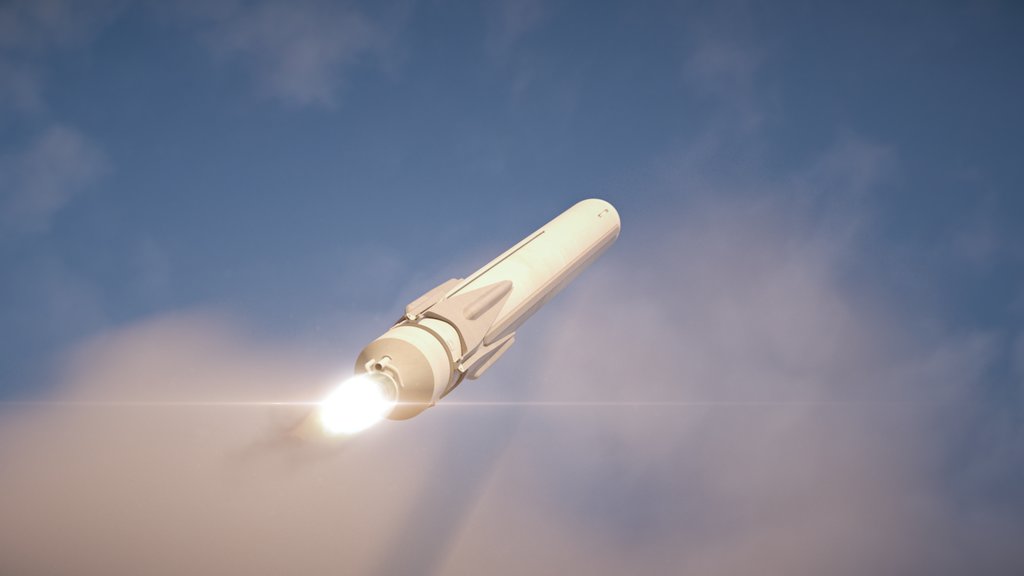 (C) CNES
(C) CNES
Blue Origin:
Founded in 2000 by the CEO of Amazon, Jeff Bezos, the company has shown itself to be very productive, developing the BE3 and BE4 engines, the suborbital touristic launch vehicle known as New Shepard, and soon the New Glenn.
The New Shepard is the company’s first launch vehicle.
 (C) Blue Origin
(C) Blue Origin
This single-stage rocket is propelled by a single BE3 engine with 49 tons of thrust. Its thrust can be reduced to 8.9 tons during the vertical landing. The ailerons on the body and the air brakes deploy as a means of controlling direction during climb and descent. Its 4 landing legs deploy just before touchdown on the Blue Origin landing zone, near the launch site.
 (C) Blue Origin
(C) Blue Origin
The cabin detaches itself once it has arrived in high altitude and offers a view of Earth from and altitude of 100km. As the stage descends, the cabin deploys its parachutes and brings the passengers to the ground.
The capsule carries 6 passengers and a habitable volume of 15 cubic meters. It has 6 windows measuring 73 cm wide and 1 m tall, making them the largest windows of a crewed scape flight.
Its solid propellant engine with 32 tons of thrust can activate for 2 seconds to shift away from the launch vehicle in case of a malfunction.
 (C) Blue Origin
(C) Blue Origin
The test of this emergency system was conclusive, the New Shepard flew 10 times without a single failure, with a propulsion time of 150 seconds and a record altitude of 101.7km. The passengers on board would feel 3 to 5 Gs maximum.
Blue Origin is also working on a launch vehicle named New Glenn, in reference to John Glenn, the first American astronaut to perform a true orbit.
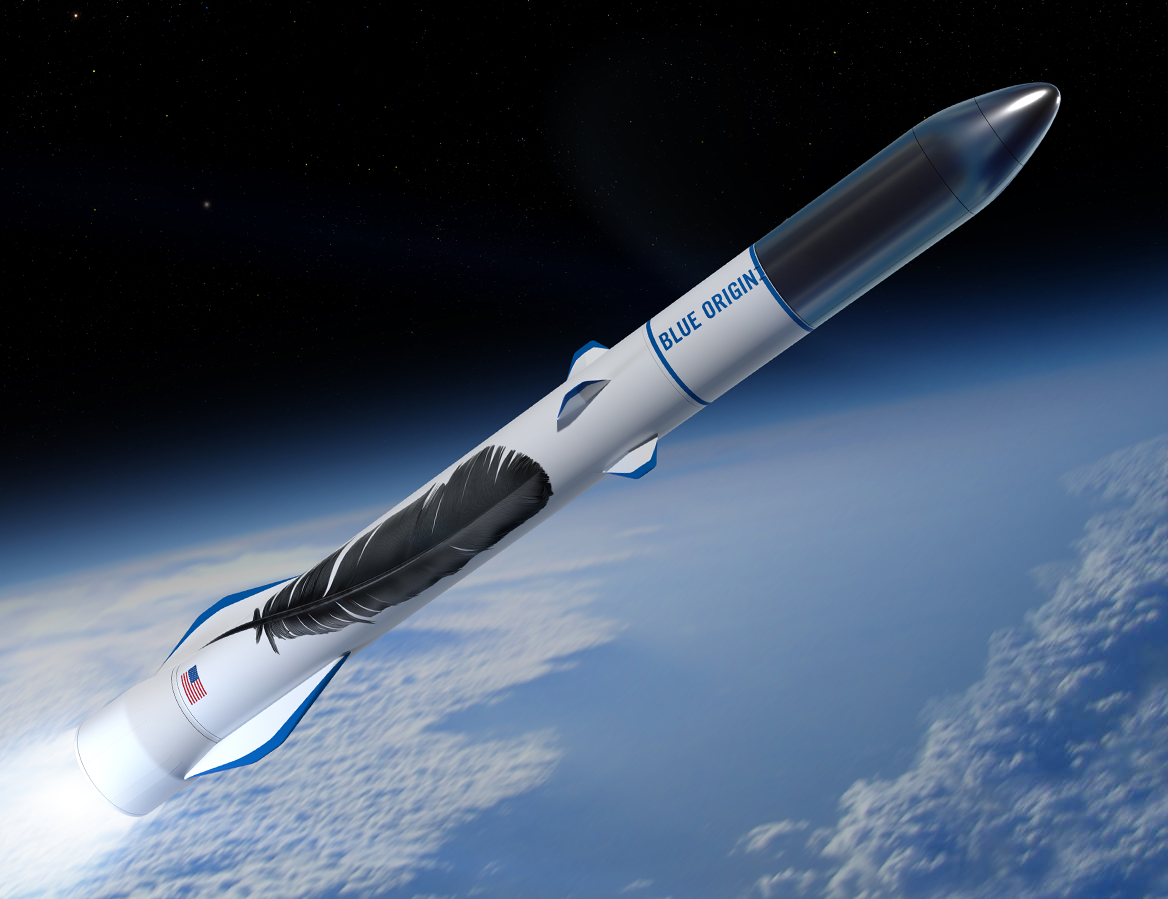 (C) Blue Origin
(C) Blue Origin
This heavy launcher will use, the same as the Vulcan of ULA, BE4 and BE3 engines. Using 2 to 3 stages of which the first will be reuseable, the launch vehicle of about 85 meters in height and 7 meters in diameter is scheduled to fly around 2021. The first stage is planned for landing on a dedicated ship.
 (C) Blue Origin
(C) Blue Origin
The Return Barges & Landing Zones:
Having a reuseable launch vehicle is good, but it has to be able to land! Let’s look again to SpaceX, who has numerous boats specially modified for the job.
The SpaceX Fleet:
Drone ships:
The drone ships, or autonomous spaceport drone ship (ASDS) are recuperation barges used by SpaceX to land Falcon 9 stages. These boats (made from simple Marmac 303s and 304s) are highly modified barges to allow for precise positioning and to withstand the landing of a launch vehicle from a height of 50m while encountering waves.
.png?uselang=fr) (C) SpaceX
(C) SpaceX
SpaceX owns (for the moment) two barges: Just Read The Instructions (removed from service in 2015) and Of Course I Still Love You (OCISLY). Soon, a third will be added: A Shortfall of Gravitas. The names all come from a series of science fiction novels written by Iain Banks.
Equipped with high precision GPS systems, blast walls to protect the containers and equipment during landing, and 4 diesel engine pods, these 90m x 50m barges can effortlessly position themselves within 3 meters of the perfect center, even with ocean swells!
Of course, the weather hitting OCISLY is a factor in the launch report!
Numerous cameras are present on the barges to provide live coverage during landings and recordings for landing attempts (that can be analyzed later).
The barges are occasionally damaged when there are failures, such as the disaster of the CRS-5 or the first flight of the Falcon Heavy. The first struck the deck at full speed, piercing it, and the second exploded off to the side and destroyed 2 engine pods.
.jpg/1200px-CRS-8_(26239020092).jpg) (C) SpaceX
(C) SpaceX
Go Quest & Elsbeth III:
These two boats are the spearheads of the drone ship operations.

Go Quest serves as a support boat for the OCISLY. The technicians board the drone ship after landing and use the Go Quest as a work station.
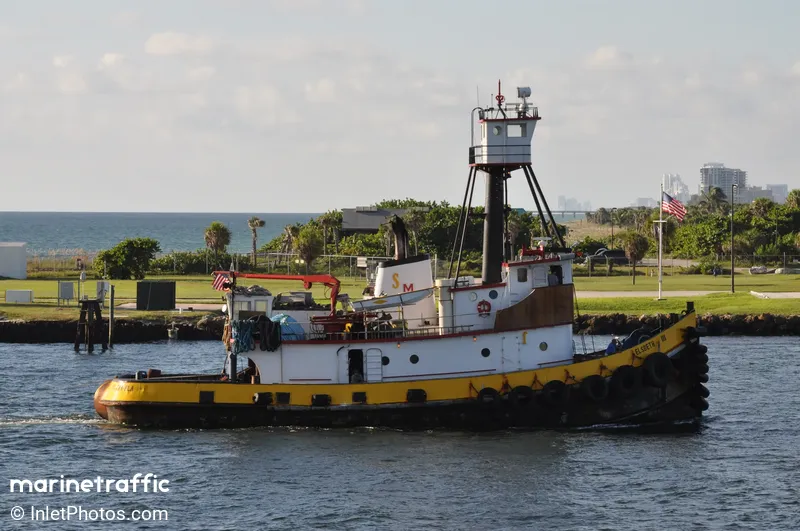
The Elsbeth III is the tug boat used by SpaceX to bring the drone ship to its general position because the barge only uses its engines to precisely position itself, not to travel distances.
Mr. Steven:
This is the SpaceX boat that we have heard about the most: it is the target for all the fairings coming down. Equipped with 4 large arms that hold open 3700 square meters of very resistant netting, this boat has seen many fairings come down next to it, but has yet to actually catch one.
 (C) SpaceX
(C) SpaceX
As previously mentioned, the fairing represents 10% of the launch cost. Mr. Steven will be the key for lowing the price!
Since my last article on this subject, the boat has seen its netting surface multiplied by 4!
Go Searcher:
SpaceX has been very discrete about this boat. From this French forum, we were able to follow the progressive modifications of the Go Searcher until it finally became the recovery ship for Crew Dragon capsules and its astronauts!
 (C) SpaceX
(C) SpaceX
Starting from a boat like the Go Quest, we saw the addition of radomes (radar domes), a crane at the rear, and a helipad. This boat was used during the DM-1 (Crew Dragon test flight) where it effectively recovered the capsule (and its parachute!).
 (C) SpaceX
(C) SpaceX
Go Navigator:
A new arrival in the fleet, the Go Navigator assists the Go Searcher in capsule recovery. It transports the equipment and technicians for all operations starting from the point of atmospheric entry up to the port docking!
 (C) SpaceX Fleet website
(C) SpaceX Fleet website
Stationary Zones:
SpaceX uses, just like Blue Origin and Callisto, stationary zones that are well anchored to the Earth to recover the Falcon Heavy boosters.
LZ-1:
The Landing Zone 1 is one of two launch vehicle landing sites situated near Cape Canaveral.
.jpg/1280px-Landing_Zone_1_(23267877284).jpg?uselang=fr) (C) SpaceX
(C) SpaceX
This former missile launch site has now become a 90m circle that accommodates the stage returns and supports all the operations related to boosters: having everything from fire suppression capabilities to WiFi, LZ-1 has everything necessary for working on the Falcons.
LZ-2:
The twin sister of LZ-1, it is situated a few hundred meters away (measured center to center), and is painted black instead of white. It completes the LZ-1/LZ-2/OCISLY set during Falcon Heavy launches!
 (C) SpaceX
(C) SpaceX
Conclusion:
No matter the company, the country, or the means, recovering even just a part of the launch vehicle (intact) is necessary to reduce the cost of launches. And so, in taking the example of SpaceX, we have seen which trajectories to take, the risks involved, needs, and future projects.
We can only wait to discover the future landing projects!
.jpg) (C) SpaceX
(C) SpaceX
Thanks for reading, Niels.
Translated by @ZiaDigitaldivah.